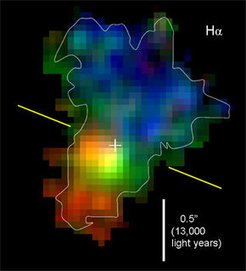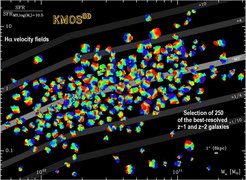Galaxy Evolution with SINS/KMOS3D/PHIBSS/NOEMA3D/GALPHYS: Witnessing the Growth of Galaxies at z ~ 1–3 through Spatially and Spectrally Resolved Studies

Spatially and spectrally resolved information of the rest-frame optical line and continuum emission is proving very powerful in exploring the physical processes that drive the baryonic mass assembly and star formation of distant galaxies. We have carried out our major surveys of near-IR imaging spectroscopy with SINFONI (SINS/zC-SINF) and KMOS (KMOS3D), and are now using ERIS at the Very Large Telescope. Together with high-resolution imaging with the Hubble Space Telescope and, most recently the James Webb Space Telescope, as well as multiline spectroscopic observations with LUCI at the Large Binocular Telescope, we are investigating in detail the resolved gas kinematics, stellar populations and structure, galactic outflows, excitation, and metallicities of young galaxies from two to eight billion years after the Big Bang. Our PHIBSS/PHIBSS2 and NOEMA3D surveys with the IRAM NOEMA millimeter interferometer provide the essential complementary view of the cold molecular gas content, distribution, and kinematics. These surveys are revealing the importance of internal galaxy dynamics in growing early disks and bulges, and the nature and energetics of feedback – pinning down for the first time details of physical processes driving and regulating early galaxy evolution in the emerging "equilibrium growth model."

SINS/zC-SINF took advantage of the unique opportunities afforded by SINFONI at ESO's Very Large Telescope on Cerro Paranal, Chile, a near-infrared integral field unit (IFU) spectrometer combined with an adaptive optics (AO) system that delivers sharp images simultaneously with high-resolution spectral information. KMOS3D, our multiyear survey with the KMOS instrument as part of Guaranteed Time Observations with MPE/OPINAS and USM, has taken the next major step toward a comprehensive and unbiased view of the resolved properties of galaxies at the heyday of massive galaxy formation. It capitalized on the worldwide unique combination of integral field spectroscopy and multiplexing of KMOS, featuring 24 integral field units patrolling a wide field of 7 arcminutes in diameter. KMOS opened up an entirely new dimension in detailed spatially and spectrally resolved studies of distant galaxies. Our comprehensive and highly successful KMOS3D survey has collected very sensitive and detailed data of 740 individual targeted objects at 0.6 < z < 2.7 (and 45 serendipitous sources), spanning a wide range in galaxy parameter space and probing into regimes unexplored so far with near-IR IFU studies, such as massive galaxies in the process of quenching their star formation activity. With the substantial improvements in angular and spectral resolution as well as sensitivity afforded by the new ERIS near-IR IFU and the Adaptive Optics Facility (AOF) at the VLT, we are now investigating the internal physics on the fundamental Toomre scale of ~ 1 kpc at z ~ 1–3. As part of MPE GTO and with support from an ERC Advanced Grant, the GALPHYS program will obtain very deep ERIS data of 50 massive star-forming disks to address the role of radial gas transport and outflows, the origin of gas turbulence, and the nature and fate of giant star-forming complexes at the peak epoch of cosmic star formation.
The reduced SINFONI+AO data from the SINS/zC-SINF AO survey are available here.
The dedicated KMOS3D survey web pages and public release of the reduced data cubes are accessible here.
The dedicated PHIBSS 1 & 2 survey web pages and public release are accessible here.
We participate in:
- IMPRS: the International Max Planck Research School on Astrophysics
We were also part of:
- DFG Priority Program SPP1177: "Witnesses of Cosmic History"

